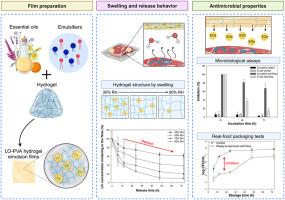Controlled release system inducing change in stability of volatile essential oil emulsion incorporated in a hydrogel using a responsive polymer for practical active food packaging
IF 11
1区 农林科学
Q1 CHEMISTRY, APPLIED
引用次数: 0
Abstract
Controlled-release systems have garnered significant interest across various industries, particularly in applications involving active compounds. The release of these compounds from packaging improves their functionality and efficiency. Active packaging systems utilizing essential oils have been extensively researched due to their antimicrobial properties and high volatility. However, their rapid depletion during the initial stages restricts their effectiveness and practical applications. This study proposes a humidity-responsive controlled-release active packaging system to overcome this challenge. To enhance emulsion stability, two nonionic emulsifiers, Tween 20 (polyoxyethylene (20) sorbitan monolaurate, water soluble) and Span 60 (sorbitan monostearate, oil soluble), were combined with polyvinyl alcohol (PVA). The resulting formulation was used as a film in the experiment. Using this system, an antimicrobial hydrogel film incorporating lemongrass essential oil (LO), a volatile antimicrobial substance, was fabricated and evaluated for its release behavior, antimicrobial activity, and mechanical properties to assess the film quality. LO-PVA hydrogel films were prepared via casting, and their humidity-responsive release was analyzed at various relative humidity (RH) levels (30, 50, 70, and 90 %) over 72 h. LO retention within the films was 61.29 ± 5.56 % at 26 % RH, decreasing to 9.98 ± 1.42 % at 90 % RH, demonstrating that the release rate of LO increased with higher humidity levels. To assess their practical applications, the antimicrobial properties of the fabricated films were evaluated using microbiological assays and real-food packaging tests with ready-to-eat food. Our findings demonstrate the effectiveness of the developed controlled-release system for fabricating and evaluating antimicrobial hydrogel films, as well as its applicability to active antimicrobial food packaging.

控制释放系统,诱导挥发性精油乳液的稳定性变化,纳入水凝胶使用反应性聚合物用于实际活性食品包装
控释系统已经引起了各行各业的极大兴趣,特别是在涉及活性化合物的应用中。这些化合物从包装中释放出来,提高了它们的功能和效率。利用精油的活性包装系统由于其抗菌性能和高挥发性而得到了广泛的研究。然而,它们在最初阶段的迅速耗竭限制了它们的有效性和实际应用。本研究提出了一种湿度响应型控释活性包装系统来克服这一挑战。为了提高乳液稳定性,将Tween 20(水溶性山梨醇单月果酸聚氧乙烯酯(20))和Span 60(油溶性山梨醇单硬脂酸酯)两种非离子乳化剂与聚乙烯醇(PVA)复合。所得配方在实验中用作薄膜。利用该体系制备了含有挥发性抗菌物质柠檬草精油(LO)的抗菌水凝胶膜,并对其释放行为、抗菌活性和力学性能进行了评价。采用浇铸法制备了LO- pva水凝胶膜,并对其在不同相对湿度(30、50、70、90%)下72 h的湿度响应释放进行了分析。在相对湿度为26%时,LO在膜内的保留率为61.29±5.56%,在相对湿度为90%时,LO的保留率降至9.98±1.42%,表明随着湿度的增加,LO的释放率增加。为了评估其实际应用,利用微生物学分析和对即食食品的实际食品包装测试来评估制备薄膜的抗菌性能。我们的研究结果证明了开发的控释系统在制备和评估抗菌水凝胶薄膜方面的有效性,以及它在活性抗菌食品包装方面的适用性。
本文章由计算机程序翻译,如有差异,请以英文原文为准。
求助全文
约1分钟内获得全文
求助全文
来源期刊

Food Hydrocolloids
工程技术-食品科技
CiteScore
19.90
自引率
14.00%
发文量
871
审稿时长
37 days
期刊介绍:
Food Hydrocolloids publishes original and innovative research focused on the characterization, functional properties, and applications of hydrocolloid materials used in food products. These hydrocolloids, defined as polysaccharides and proteins of commercial importance, are added to control aspects such as texture, stability, rheology, and sensory properties. The research's primary emphasis should be on the hydrocolloids themselves, with thorough descriptions of their source, nature, and physicochemical characteristics. Manuscripts are expected to clearly outline specific aims and objectives, include a fundamental discussion of research findings at the molecular level, and address the significance of the results. Studies on hydrocolloids in complex formulations should concentrate on their overall properties and mechanisms of action, while simple formulation development studies may not be considered for publication.
The main areas of interest are:
-Chemical and physicochemical characterisation
Thermal properties including glass transitions and conformational changes-
Rheological properties including viscosity, viscoelastic properties and gelation behaviour-
The influence on organoleptic properties-
Interfacial properties including stabilisation of dispersions, emulsions and foams-
Film forming properties with application to edible films and active packaging-
Encapsulation and controlled release of active compounds-
The influence on health including their role as dietary fibre-
Manipulation of hydrocolloid structure and functionality through chemical, biochemical and physical processes-
New hydrocolloids and hydrocolloid sources of commercial potential.
The Journal also publishes Review articles that provide an overview of the latest developments in topics of specific interest to researchers in this field of activity.
 求助内容:
求助内容: 应助结果提醒方式:
应助结果提醒方式:


